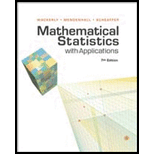
a.
Find the marginal density
a.
Answer to Problem 149SE
The marginal probability density function of
Explanation of Solution
Calculation:
Consider that
Then, the marginal probability functions of
Thus, marginal probability density function of
Thus, the marginal probability density function of
Similarly, marginal probability density function of
Thus, the marginal density function for
b.
Find the value of
b.
Answer to Problem 149SE
The value of
Explanation of Solution
Calculation:
Conditional distribution and density function:
Consider that
Now, the conditional distribution function of
Now, for any
Similarly, for any
From Part (a), it is found that the marginal probability density function of
Hence, using the marginal probability functions the required probability is obtained as,
Thus, the value of
c.
Find the conditional density
c.
Answer to Problem 149SE
The conditional density
Explanation of Solution
Using the joint probability function of
Thus, the conditional density
d.
Find the value of
d.
Answer to Problem 149SE
The value of
Explanation of Solution
Calculation:
From Part (C), it is obtained that the conditional density
Hence, the required probability is obtained as,
Thus, the value of
Want to see more full solutions like this?
Chapter 5 Solutions
Mathematical Statistics with Applications
- A soda can has a volume of 25 cubic inches. Let x denote its radius and h its height, both in inches. a. Using the fact that the volume of the can is 25 cubic inches, express h in terms of x. b. Express the total surface area S of the can in terms of x.arrow_forwardA soda can is made from 40 square inches of aluminum. Let x denote the radius of the top of the can, and let h denote the height, both in inches. a. Express the total surface area S of the can, using x and h. Note: The total surface area is the area of the top plus the area of the bottom plus the area of the cylinder. b. Using the fact that the total area is 40 square inches, express h in terms of x. c. Express the volume V of the can in terms of x.arrow_forwardASAPPParrow_forward
- Please show all the steps and calculations with broad explanations.arrow_forward2. Let f(x₁, X2, X3, X4) be the joint density function of (X₁, X2, X3, X 4). Then the joint density of (X3, X 4) is obtained from f(x₁, X2, X3, X4) by integrating x, and x2, over the Cartesian plane. True or False. Circle one. Provide reason for the answer.arrow_forwardSuppose X and Y have joint density f(x,y)=10x2y, 0<y<x<1. Find the marginal density of X.arrow_forward
- Let X and Y be jointly continuous with density fxy (x, y) = 2xy for 0 < 2y < x < 2. Let fy (y) be the marginal density of Y. Then fy ;) is equal toarrow_forwardFind (,) for the lamina of uniform density p bounded by the graphs of the equations x = 169-y² and x = 0. 0 (7,5) = (0, 338) O 5 O (7.5)=(338.0) y) 0 (7.5)=(0.676) O y) 26 0 (F.J) = (2.0) O 0 (57.5J) = (676,0) O (x,y)arrow_forwardThe time T a business is closed after a fire has the cumulative distribution function (부)- 3 1 1 F7(t) = t>0 t+1 otherwise = VT. The cost to the insurer is X = Determine the density of X for x > 0.arrow_forward
- Let f(x) is density function then J f(x)dx = 1 صوابarrow_forwardThe joint density function of Y1 and Y, is given by Jyn + Y2, 0< Yı < 1,0 < y2 < 1, f(y1, 42) = 0, _A elsewhere a) Find marginal density functions. Are Y1 and Y, independent? b) Could you tell whether Y1 and Y2 were independent or not without finding marginal density functions? Explain. fo c) Find P(Y1 +Y½ < 0.2). d) Find P(0 < Y½ < 0.5|Y1 = 0.4).arrow_forwardSuppose X and Y have joint density f(x, y) = x + y 0 < x < 1,0 < y < 1. What is E(XY2)arrow_forward
- Algebra & Trigonometry with Analytic GeometryAlgebraISBN:9781133382119Author:SwokowskiPublisher:Cengage
 Functions and Change: A Modeling Approach to Coll...AlgebraISBN:9781337111348Author:Bruce Crauder, Benny Evans, Alan NoellPublisher:Cengage Learning
Functions and Change: A Modeling Approach to Coll...AlgebraISBN:9781337111348Author:Bruce Crauder, Benny Evans, Alan NoellPublisher:Cengage Learning

